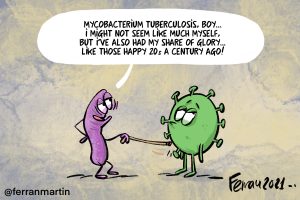Search
Cristina Crava, Ramón y Cajal researcher at the BIOTECMED group, develops techniques to improve the use of entomopathogens to control crop pests.
Pilar Domingo Calap combines her Ramón y Cajal research work at I2SysBio, where she leads the «Environmental and Biomedical Virology» group, with teaching at the University of Valencia in the Department of Genetics.
Wild animals can be environmental watchdogs that inform us about antimicrobial resistance.
The use of phages in biomedicine can address the problem of multi-resistant bacteria. However, there are some weak points we must overcome before using them in clinical practice.
Antibiotic-resistant bacteria are one of the main causes of death in the world, according to a publication in The Lancet.
On 24 March 1882, Robert Koch announced his discovery of the Mycobacterium that causes tuberculosis.
Maurice Hilleman is probably the scientist who has prevented the highest number of deaths and illnesses from infection in the history of medicine. He and his team obtained or improved more than 25 vaccines against viruses and bacteria.
The evolution of antibiotic resistance is probably the most spectacular example of evolution of a biological system innovation that we have had the opportunity to observe in real time.
The answer to this is yes. Plants can reproduce errors in the growth of some cells, which would cause the formation of cell masses or tumours that could be considered cancers.
«Detailed evidence shows that Nietzsche passed through each of the three stages: the chancre of primary syphilis; the terrible pox, fever and pain of secondary syphilis; and the dreaded third, paresis» In the foothills of the Italian Alps, on a snow-draped piazza in Turin, on January










